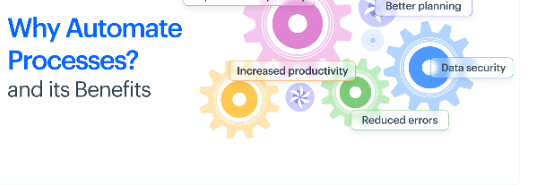Streamlining and improving the efficiency of business operations is, perhaps, one of the most important tasks of management today. There is always room for improvement when it comes to the basic daily operations of a business and workflow and other automation software make this easier than ever before.
Streamlining workflow through automation has end up vital in modern-day dynamic enterprise panorama. With the ever-increasing demands for performance and productivity, businesses are constantly seeking methods to streamline their strategies. Automation Tips gives an answer via leveraging generation to automate repetitive tasks, permitting employees to cognizance on greater strategic and value-added sports. In this newsletter, we will delve into realistic recommendations for streamlining workflow with automation, little by little, ensuring that businesses can optimize their operations effectively.
Automation no longer only complements performance but also reduces mistakes and operational charges, making it a important thing of current business techniques. By figuring out and automating repetitive tasks, groups can loose up treasured time and resources, enabling them to allocate their workforce to more strategic initiatives. In the subsequent sections, we will discover numerous aspects of workflow automation, from deciding on the right equipment to measuring fulfillment and overcoming demanding situations, presenting readers with actionable insights to streamline their workflows correctly.
What is a streamlined process?

Streamlining processes refers to the practice of identifying and eliminating repetitive and unnecessary steps or activities in a process in order to make it more efficient and effective. The goal of streamlining processes is to reduce waste, improve efficiency, and increase productivity. It includes leveraging modern technologies in the place of manual labor.
Many processes across numerous departments can be streamlined, and sometimes, a good workflow software will do a lot of the heavy lifting for you. Human resources can streamline processes for onboarding, Operations can streamline maintenance processes, Compliance officers can streamline quarterly reporting, Marketing can streamline follow-up emails, Finance can streamline spend management and much more.
Streamline workflow with these automation tips
Sometimes these processes that should be simple are convoluted by excessive, unnecessary tasks which is why you’ll want to follow these tips to streamline processes and cut busy work.
- Identifying Repetitive Tasks: The first step in streamlining workflows is identifying tasks that are repetitive and time-consuming. This may include data entry, document approval processes, or customer inquiries. Keeping track of these tasks can help prioritize them for automation.
- Create several processes: One big problem with busy work is that even if you make a process that seems to cut it, it may very well pop up in unexpected places. Rather than just making one process to streamline your work, try making several. While it seems like a lot of legwork, you’ll come up with exciting and inventive ways to cut some aspects out of your workflow, see where the repetition lies, and potentially rearrange or rethink process-hindering status updates.
- Automation: What’s the most effective and most straightforward way to cut out busywork? Automate it! If you’ve got the right tech, you can trigger purchase orders to send automatically once a task is completed, install a code that sends out a marketing follow-up email blast, transfer information from one app to another, or any number of other essential tasks. As long as you can identify which parts of the process are the most feasible to streamline and how you’ll accomplish it, anything’s is possible when it comes to automating tasks.
- Streamlining Communication Processes: Automation can streamline communication processes by automating email responses and using chatbots for customer support. This reduces response times and improves customer satisfaction.
- Automating Data Entry and Processing: Data entry and processing tasks can be automated using forms, templates, and data extraction tools. This not only saves time but also minimizes errors associated with manual data entry.
- Integrating Software Systems: Integrating software systems allows for seamless data flow between different applications. This improves collaboration and eliminates the need for manual data transfer, saving time and reducing errors.
- Ensuring Security and Compliance: Security and compliance are critical considerations when implementing Automation Tips. It’s essential to address security concerns and ensure that automated processes comply with relevant regulations and standards.
- Training and Support for Employees: Providing adequate training and support for employees is essential for successful automation implementation. This ensures that employees understand how to use new tools effectively and can troubleshoot any issues that arise.
- Measuring and Analyzing Automation Success: Measuring key metrics such as efficiency gains and ROI is crucial for evaluating the success of automation efforts. Analyzing data allows businesses to identify areas for improvement and optimize automated processes further.
Future Trends in Workflow Automation Tips:
The future of workflow automation is promising, with emerging technologies such as artificial intelligence and machine learning driving innovation. Businesses can expect to see continued advancements in automation capabilities, further enhancing productivity and efficiency.
Do you have a system for managing everything? If not, you’ll soon be overwhelmed. That’s why efficient workflows are critical. Workflows are really the act of carrying out processes and creating a system that works for you, so that you can get more done in less time (and with less stress). You can develop a workflow for everything from showering in the morning to accomplishing important work initiatives. The point is that there is an intentional system and you’re not just going through your day trying to absorb everything that life throws at you.
Here’s some good news: if you understand your workflows, you can take efforts to optimize them. How can you reduce the necessary steps and limit the time spent on each task? By streamlining your workflows you’ll not only be more productive, you’ll have more peace of mind and time. Luckily, there are tools like Bizzyeasy that will help you efficiently set up and execute on your process. Here are a few ways Bizzyeasy can help:
- Robust CRM: Streamline operations, boost team efficiency, and make data-driven decisions to unlock business growth
- Scheduling capabilities to set deadlines and keep projects on track.
- Communication features (chat, email, Zoom integration) to keep everyone in the loop about changes and updates, so everyone is working from the same page.
- Document management capabilities to keep all project-related documents and artifacts organized and accessible.
- Management capabilities to delegate tasks and ensure accountability, track progress and measure performance.
- Reporting feature to quickly analyze the current status of a project and use the data to identify areas of improvement.
- Collaboration capabilities to create a unified workspace where communication and collaboration between team members is encouraged and facilitated.
- Integrate with third-party tools such as Dropbox, Google Drive, and Slack, so you have all the tools you need at your fingertips.
- Templates and checklists. Applying a project template to a new or existing project allows you to easily bring in a set of actions with pre-specified assignees, due dates and information. No need to recreate the wheel each time you kick off the same workflow. Let templates do the work for you!
Conclusion:
Enforcing workflow automation is a strategic move for any business trying to stay competitive and green in modern day rapid-paced environment. By following the step-by way of-step recommendations outlined in this article, groups can streamline their methods, reduce mistakes, and improve productiveness. From figuring out repetitive responsibilities to choosing the proper automation tools and measuring fulfillment, each step is crucial in making sure a easy transition to computerized workflows.
It can be overwhelming to improve business processes when you don’t have the right strategy or tools.
Bizzyeasy is a simple yet powerful low-code platform that allows you to streamline and automate processes without requiring technical expertise. Business users can make changes to their processes in real-time and use the intuitive reporting dashboard to measure the efficiency of processes and create built-in reports.
Transform your business processes with Bizzyeasy and experience improved agility.
